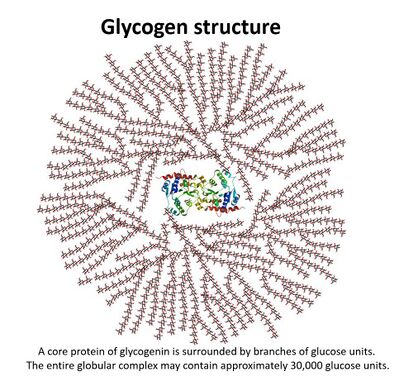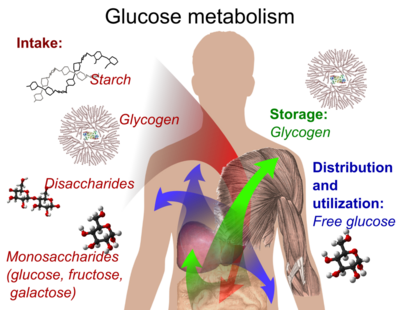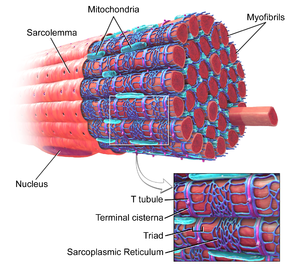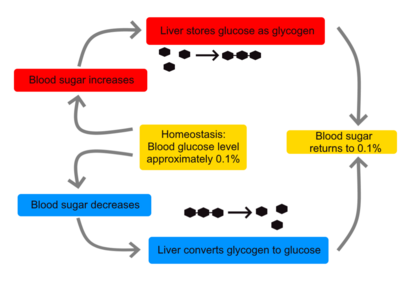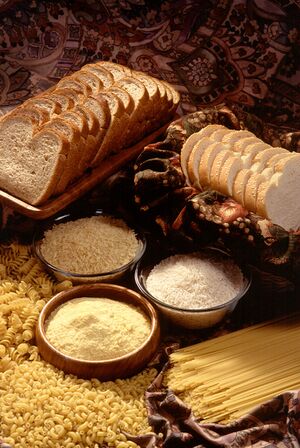Glycogen
Original Editor - User Name
Top Contributors - Lucinda hampton
Introduction[edit | edit source]
Muscle glycogen is an important fuel source during exercise. Inadequate glycogen availability results in reduced endurance exercise capacity and an inability to continue exercise[1].
The body breaks down most carbohydrates (CHO) from the foods we eat and converts them to a type of sugar called glucose. Glucose is the main source of fuel for our cells. Glycogen is the stored form of glucose (made up of many connected glucose molecules).
Glycogen is stored in the muscles and liver When the body needs a quick boost of energy or when the body isn't getting glucose from food, glycogen is broken down to release glucose into the bloodstream to be used as fuel for the cells[2].
Image 1: Schematic two-dimensional cross-sectional view of glycogen. A core protein of glycogenin is surrounded by branches of glucose units. The entire globular granule may contain around 30,000 glucose units.
Storage[edit | edit source]
Glycogen is the molecular form of carbohydrates stored in humans and other mammals. A glycogen particles in skeletal muscles can contain as much as 50,000 glucose units. In humans the majority of glycogen is stored in skeletal muscles (∼500 g) and the liver (∼100 g).
- Approximately 80% of the glycogen is stored in skeletal muscles, simply because skeletal muscles account for ∼40–50% of body weight.
- The liver has a higher glycogen concentration, but as the liver is much smaller (∼1.5 kg) the total amount of liver glycogen is ∼100 g.
- Other tissue, like the heart and brain contains minor glycogen stores with important physiological function[3].
Image 2: Glucose metabolism and various forms of it in the process. Glucose-containing compounds are digested and taken up by the body in the intestines, including starch, glycogen, disaccharides and as monosaccharide. Glucose is stored in mainly the liver and muscles as glycogen. It is distributed and utilized in tissues as free glucose.
- While glycogen provides a ready source of energy, it is quite bulky with heavy water content, so the body cannot store much of it for long. Fats however can serve as a larger and more long-term energy reserve. Fats pack together tightly without water and store far greater amounts of energy in a reduced space.[4]
Muscle Storage Glycogen: The spherical glycogen molecules are located in three distinct subcellular compartments within skeletal muscle:
- intermyofibrillar glycogen, which accounts for approximately three-quarters of total glycogen and is situated near mitochondria between the myofibrils.
- subsarcolemmal glycogen, which accounts for ∼5–15% of all glycogen, and
- intramyofibrillar glycogen, which also accounts for ∼5–15% of total glycogen. During prolonged exercise, glycogen in all three compartments is used but only intramyofibrillar glycogen becomes depleted[1].
Image 3: Sarcolema, SkeletalMuscle.
Function[edit | edit source]
A main function of glycogen is to maintain a physiological blood glucose concentration, but only liver glycogen directly contributes to release of glucose into the blood. Liver glycogen content decreases rapidly during fasting and the liver glycogen content decreases by ∼65% after 24 h fasting.
- Skeletal muscles are unable to release glucose (because muscles lack glucose 6-phosphatase) and muscles glycogen is mainly a local energy substrate for exercise (rather than an energy source to maintain blood glucose concentration during fasting).
- In the heart and the brain, glycogen is also an energy substrate that can generate anaerobic energy during short-term oxygen deficiency contributing to survival[3].
Image 4: A diagram of regulation of blood sugar through negative feedback and conversion of glucose to/from glycogen.
Physiotherapy[edit | edit source]
As health professionals involved in exercise therapy it is important to educate our clients on the importance of nutrition. During post exercise recovery, optimal nutritional intake is important to replenish endogenous substrate stores and to facilitate muscle-damage repair. With muscle glycogen contributing more than 50% of total energy requirements during prolonged moderate to high-intensity exercise, post exercise carbohydrate (CHO) ingestion will determine how quickly muscle glycogen is restored and therefore how quickly the athlete recovers[5].
- For rapid recovery from prolonged exercise, it is important to replenish muscle glycogen stores and initiate muscle tissue repair and adaptation.
- To maximize muscle glycogen replenishment, it is important to consume a CHO supplement as soon after exercise as possible.
- CHO intake ranges of 5 to 7 g/kg/day for general training needs and 7 to 10 g/kg/day for the increased needs of endurance athletes are suggested[6].
- Efficiency of muscle glycogen storage can be increased significantly with the addition of protein to a CHO supplement (~4 to 1 carbohydrate to protein ratio).
- The addition of protein to a CHO supplement also has the added advantage of limiting post exercise muscle damage and promoting muscle protein accretion.[7]
Image 5: CHO grain products
References[edit | edit source]
- ↑ 1.0 1.1 Schweitzer GG, Kearney ML, Mittendorfer B. Muscle glycogen: where did you come from, where did you go?. The Journal of physiology. 2017 May 1;595(9):2771.Available:https://physoc.onlinelibrary.wiley.com/doi/full/10.1113/JP273536 (accessed 20.11.2021)
- ↑ Teenshealth Definition Glycogen Available:https://kidshealth.org/en/teens/glycogen.html (accessed 19.11.2021)
- ↑ 3.0 3.1 Jensen J, Rustad PI, Kolnes AJ, Lai YC. The role of skeletal muscle glycogen breakdown for regulation of insulin sensitivity by exercise. Frontiers in physiology. 2011 Dec 30;2:112.Available:https://www.ncbi.nlm.nih.gov/pmc/articles/PMC3248697/ Accessed 19.11.2021
- ↑ Maricopa Lidids Available:https://open.maricopa.edu/nutritionessentials/chapter/lipids/ (accessed 20.11.2021)
- ↑ POGO Nutrition for recovery of endurance activity Available:https://www.pogophysio.com.au/blog/nutrition-for-recovery-of-endurance-activity/ (accessed 20.11.2021)
- ↑ Burke LM, Cox GR, Cummings NK, Desbrow B. Guidelines for daily carbohydrate intake. Sports medicine. 2001 Apr;31(4):267-99. Available: https://link.springer.com/article/10.2165/00007256-200131040-00003(accessed 20.11.2021)
- ↑ Ivy JL. Regulation of muscle glycogen repletion, muscle protein synthesis and repair following exercise. Journal of sports science & medicine. 2004 Sep;3(3):131.Available:https://www.ncbi.nlm.nih.gov/pmc/articles/PMC3905295/ (accessed 19.11.2021)
